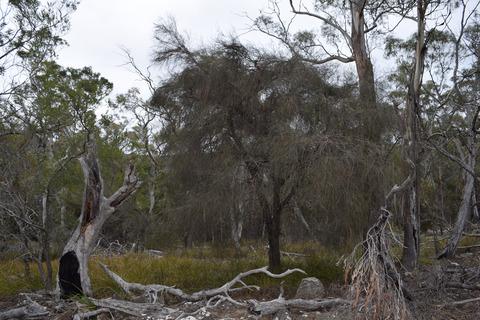当前位置:
X-MOL 学术
›
Funct. Ecol.
›
论文详情
Our official English website, www.x-mol.net, welcomes your feedback! (Note: you will need to create a separate account there.)
Lack of vulnerability segmentation among woody species in a diverse dry sclerophyll woodland community
Functional Ecology ( IF 5.2 ) Pub Date : 2020-04-01 , DOI: 10.1111/1365-2435.13519 Chris M. Smith‐Martin 1 , Robert Paul Skelton 2 , Kate M. Johnson 3 , Christopher Lucani 3 , Timothy J. Brodribb 3
Functional Ecology ( IF 5.2 ) Pub Date : 2020-04-01 , DOI: 10.1111/1365-2435.13519 Chris M. Smith‐Martin 1 , Robert Paul Skelton 2 , Kate M. Johnson 3 , Christopher Lucani 3 , Timothy J. Brodribb 3
Affiliation

|
Recent findings suggest that tree mortality and post‐drought recovery of gas exchange can be predicted from loss of function within the water transport system. Understanding the susceptibility of plants to hydraulic damage requires knowledge about the vulnerability of different plant organs to stress‐induced hydraulic dysfunction. This is particularly important in the context of vulnerability segmentation between plant tissues which is believed to protect more energetically ‘costly’ tissues, such as woody stems, by sacrificing ‘cheaper’ leaves early under drought conditions. Differences in vulnerability segmentation between co‐occurring plant species could explain divergent behaviours during drought, yet there are few studies considering how this characteristic may vary within a plant community. Here we investigated community‐wide vulnerability segmentation by comparing leaf/shoot and stem vulnerability in all coexistent dominant canopy and understory woody species in a diverse dry sclerophyll woodland community, including multiple angiosperms and one gymnosperm. Previously published terminal leaf/shoot vulnerability to loss of water transport capacity was compared with stem xylem vulnerability to embolism measured on the same species at the same site. We calculated hydraulic safety margins for stems to determine variation in the risk of hydraulic failure during drought among species. The xylem of all species was found to be highly resistant to hydraulic dysfunction, with only two of the eight species exhibiting significantly different vulnerability to the overall mean. No evidence of vulnerability segmentation between shoots/leaves and stems was found in seven of the eight species. Phylogenetically diverse canopy and understory species in this evergreen sclerophyll woodland appear to have evolved similar strategies of drought resistance, including low xylem vulnerability to embolism and general lack of vulnerability segmentation. This convergence in hydraulic safety indicates a lack of hydraulic niche partitioning in this woodland community. A free plain language summary can be found within the Supporting Information of this article.
中文翻译:

不同干燥硬叶林地群落中木本物种之间缺乏脆弱性分割
最近的研究结果表明,树木死亡和干旱后气体交换的恢复可以通过水运输系统功能的丧失来预测。了解植物对水力损害的敏感性需要了解不同植物器官对压力引起的水力功能障碍的脆弱性。这在植物组织之间的脆弱性分割背景下尤为重要,人们认为植物组织通过在干旱条件下早期牺牲“更便宜”的叶子来保护更“昂贵”的组织,例如木本茎。共生植物物种之间脆弱性分割的差异可以解释干旱期间的不同行为,但很少有研究考虑这种特征在植物群落内可能如何变化。在这里,我们通过比较包括多种被子植物和一种裸子植物在内的多样化干燥硬叶林群落中所有共存的优势树冠和林下木本物种的叶/芽和茎脆弱性来研究社区范围内的脆弱性分割。先前公布的末端叶/芽对水分运输能力损失的脆弱性与在同一地点的同一物种测量的茎木质部对栓塞的脆弱性进行了比较。我们计算了茎的水力安全裕度,以确定不同物种在干旱期间水力故障风险的变化。发现所有物种的木质部都对水力功能障碍具有高度抵抗力,八个物种中只有两个对整体平均值表现出显着不同的脆弱性。在八种物种中的七种中没有发现枝条/叶和茎之间脆弱性分割的证据。在这片常绿硬叶林地中,系统发育多样化的树冠和林下物种似乎已经进化出类似的抗旱策略,包括木质部对栓塞的低脆弱性和普遍缺乏脆弱性分割。水力安全的这种融合表明该林地社区缺乏水力生态位分区。可以在本文的支持信息中找到免费的简明语言摘要。包括低木质部对栓塞的脆弱性和普遍缺乏脆弱性分割。水力安全的这种融合表明该林地社区缺乏水力生态位分区。可以在本文的支持信息中找到免费的简明语言摘要。包括低木质部对栓塞的脆弱性和普遍缺乏脆弱性分割。水力安全的这种融合表明该林地社区缺乏水力生态位分区。可以在本文的支持信息中找到免费的简明语言摘要。
更新日期:2020-04-01
中文翻译:

不同干燥硬叶林地群落中木本物种之间缺乏脆弱性分割
最近的研究结果表明,树木死亡和干旱后气体交换的恢复可以通过水运输系统功能的丧失来预测。了解植物对水力损害的敏感性需要了解不同植物器官对压力引起的水力功能障碍的脆弱性。这在植物组织之间的脆弱性分割背景下尤为重要,人们认为植物组织通过在干旱条件下早期牺牲“更便宜”的叶子来保护更“昂贵”的组织,例如木本茎。共生植物物种之间脆弱性分割的差异可以解释干旱期间的不同行为,但很少有研究考虑这种特征在植物群落内可能如何变化。在这里,我们通过比较包括多种被子植物和一种裸子植物在内的多样化干燥硬叶林群落中所有共存的优势树冠和林下木本物种的叶/芽和茎脆弱性来研究社区范围内的脆弱性分割。先前公布的末端叶/芽对水分运输能力损失的脆弱性与在同一地点的同一物种测量的茎木质部对栓塞的脆弱性进行了比较。我们计算了茎的水力安全裕度,以确定不同物种在干旱期间水力故障风险的变化。发现所有物种的木质部都对水力功能障碍具有高度抵抗力,八个物种中只有两个对整体平均值表现出显着不同的脆弱性。在八种物种中的七种中没有发现枝条/叶和茎之间脆弱性分割的证据。在这片常绿硬叶林地中,系统发育多样化的树冠和林下物种似乎已经进化出类似的抗旱策略,包括木质部对栓塞的低脆弱性和普遍缺乏脆弱性分割。水力安全的这种融合表明该林地社区缺乏水力生态位分区。可以在本文的支持信息中找到免费的简明语言摘要。包括低木质部对栓塞的脆弱性和普遍缺乏脆弱性分割。水力安全的这种融合表明该林地社区缺乏水力生态位分区。可以在本文的支持信息中找到免费的简明语言摘要。包括低木质部对栓塞的脆弱性和普遍缺乏脆弱性分割。水力安全的这种融合表明该林地社区缺乏水力生态位分区。可以在本文的支持信息中找到免费的简明语言摘要。


























 京公网安备 11010802027423号
京公网安备 11010802027423号